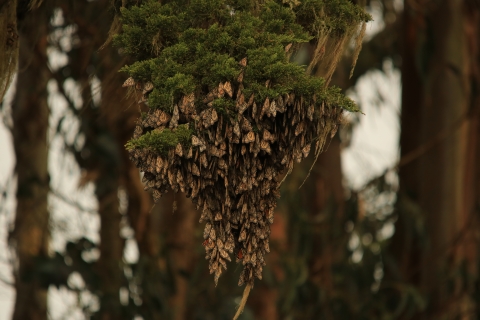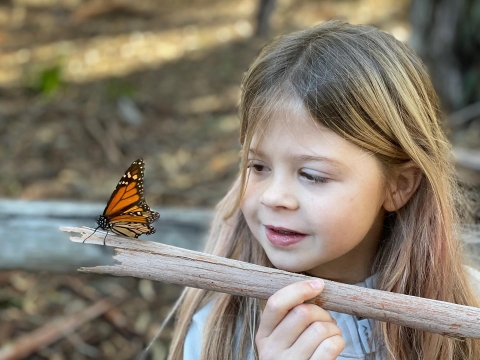Steve Henry, Field Supervisor, U.S. Fish and Wildlife Service
After 31 years as a biologist with the U.S. Fish and Wildlife Service in Ventura, I continue to be enamored by the flora and fauna of our California coast, and the iconic monarch butterfly is no exception.
There is something magical about the graceful fluttering of orange and black wings – a fond memory of my childhood growing up in Oxnard. The monarch’s multi-generational migration seems fueled by magic itself but is an unparalleled feat of nature requiring specific environmental conditions.
As a California native, I often enjoy visiting the monarchs at overwintering sites at El Camino Real in Ventura and Goleta to gaze up at the monarch chandeliers hanging in the coastal monarch groves.
Sadly, monarch numbers have faced an astounding 95 percent decline at important overwintering sites along the California coast, dropping from more than 4.5 million in the 1980s to fewer than 2,000 in 2020. The decline is a culmination of multiple stressors from loss and degradation of overwintering groves and loss of breeding and migratory habitat to climate change climate change
Climate change includes both global warming driven by human-induced emissions of greenhouse gases and the resulting large-scale shifts in weather patterns. Though there have been previous periods of climatic change, since the mid-20th century humans have had an unprecedented impact on Earth's climate system and caused change on a global scale.
Learn more about climate change , parasites and disease, and pesticide use, particularly insecticides.
Counties across the Central California Coast can lead the way by championing initiatives to support monarchs and you too can do your part. Local gardeners, landowners, and nurseries all play a key role to help monarchs thrive.
Here's how you can help:
- Plant native nectar plants such as California bush sunflower, yarrow, and coyote bush found at your local nursery. These flowering plants provide the nourishment and habitat monarchs need.
- If you live at least one mile from the coast, plant early season native milkweed (narrow leaf milkweed, California milkweed, or Indian milkweed). It is important to plant milkweeds that leaf out early in the season because monarchs are known to leave overwintering sites earlier due to climate change. Try to plant pesticide free milkweed whenever possible. Avoid planting milkweed closer to the coast near monarch overwintering sites because it can interrupt their natural lifecycle and reduce migration. Milkweed did not historically occur on the coast.
- Do not plant nonnative tropical milkweed because it can result in year-round breeding, increase parasites on monarchs, and the loss of monarch’s migratory behavior. Did you know that the State of California categorizes tropical milkweed as a pest of known environmental detriment? Ventura County has declared it a noxious weed, implementing a ban on the sale of tropic milkweed commercially.
- Use alternatives to pesticides, and particularly insecticides, because they are toxic to monarch butterflies and other pollinators.
- Be a monarch butterfly champion by educating others about how they can help.
Download the poster here.
Why is tropical milkweed bad for monarchs? Data shows that nonnative, tropical milkweed can spread disease to monarchs that is linked to reductions in body mass, lifespan, mating success, and flight ability. Because tropical milkweed continues to flower and produce new leaves throughout fall and winter, it allows monarchs to breed all year long which can reduce or eliminate their migratory instinct. This non-migratory behavior can foster higher levels of transmission of a debilitating parasite called Ophryocystis elektroscirrha. Native milkweed dies back seasonally and is typically absent during winter months, so it does not interfere with the monarch’s migratory cycle, thus reducing the risk of disease. Nurseries that offer native milkweed play an important role in reducing this parasite on the landscape.
Due in no small part to the efforts of citizens, scientists, land managers, and nurseries taking action to help save the monarch, there is reason for cautious optimism. In 2021, scientists from the Xerces Society documented an increase in monarch numbers along our California coast, a glimmer of hope as we put in the work to prevent their extinction.
The Department of the Interior and the U.S. Fish and Wildlife Service continue to support habitat restoration and monarch education. In June, Secretary of the Interior Deb Haaland hosted a two-day summit to share the latest science and conservation actions being taken to address the long-term population decline of the western monarch butterfly. The Department also announced crucial steps to invest in monarch conservation, including new funding and programs ensure the survival of the monarch butterfly and other pollinators.
Our Partners for Fish and Wildlife Program has also worked with the Ventura County Resource Conservation District, among others, to fund on-the-ground habitat restoration for monarchs along the central California coast, including at the Hueneme Masonic Cemetery in Oxnard this past year.
We worked with University of California students to develop monarch-friendly plant signage for local nurseries to educate gardeners about native plants that support monarchs at different stages of their lifecycle. We are also proud to fund our 2022 Kendra Chan Conservation Fellowship focusing on monarch research, education, and outreach.
Local communities from nurseries to neighborhoods remain critical to monarch conservation now and in the future. Let's continue to work together to keep the magic of monarchs alive.







